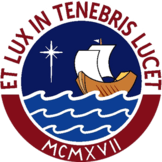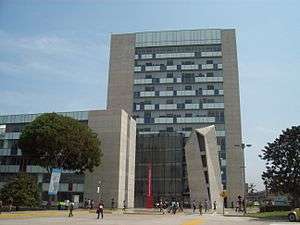Pontifical Catholic University of Peru
Pontifical Catholic University of Peru (Spanish: Pontificia Universidad Católica del Perú, PUCP) is a private university in Lima, Peru. It was founded in 1917 with the support and approval of the Catholic Church. The person who dealt the necessary formalities was Catholic priest Father Jorge Dintilhac SS.CC. This University was the Peru's first non-State institution of higher learning. Academically, PUCP ranks alternatively as first[1][2][3] or second[4][5] in Peru.
Pontificia Universidad Católica del Perú | |
 | |
| Motto | Et lux in tenebris lucet |
|---|---|
Motto in English | And the light shines in the darkness |
| Type | Private University Secular university claiming Roman Catholic affiliation |
| Established | 1 March 1917 (103 years ago) |
| Founder | Jorge Dintilhac |
| Chancellor | Giuseppe Versaldi |
| Rector | Carlos Garatea Grau |
Academic staff | 3,122 |
Administrative staff | 3,021 |
| Students | 29,044 (2018) |
| Undergraduates | 22,711 (2018) |
| Postgraduates | 6,333 (2018) |
| 393 (2018) | |
| Address | Av. Universitaria cuadra 18, San Miguel , , |
| Campus | Urban 0.41 km2 |
| Colors | Navy blue Maroon |
| Affiliations | Consorcio de Universidades, COLUMBUS, FIUC, Asociación Internacional de Universidades (IAU), OUI, RPU, UDUAL. |
| Website | www |
In July 2012, after an apostolic visitation, begun earlier, in 2011, by Cardinal Peter Erdo, Archbishop of Esztergom-Budapest, Hungary, the Holy See withdrew from the university the right under canon law to use the titles Catholic and Pontifical in its name. Titles like "Catholic" and "Pontifical" are granted by Vatican only after meeting legal requirements. However, on Monday, 28 April 2014, the Rector of the University stated that,: "The Holy Father, Pope Francis, has formed a Commission of Cardinals with the mission of meeting to find a 'final, consensual solution,' in the framework of the Apostolic Constitution 'Ex Corde Ecclesiae,' ('From the Heart of the Church') to the outstanding issues" between the Vatican and the University." Besides Cardinal Erdo, the other two Cardinal Members of the Commission will be Cardinal Gérald Lacroix, Archbishop of Quebec City, Quebec, Canada, and Cardinal Ricardo Ezzati Andrello, Archbishop of Santiago de Chile, Chile.[6] In 2016, Vatican restored the lost titles and determined that Archbishop of Lima will not assume ever the position of Chancellor of the University. It was a sort of appeasement for rebel authorities because Archbishop of Lima, Juan Luis Cipriani, was the main advocate of the Vatican interests. Nevertheless, nowadays (December 2018) those authorities are facing charges, and Rector Marcial Rubio had to resign after a scandal of undue and abusive charges of students.[7]
Academic development
The University began activities in 1917 with two schools: Letters and Laws. In 1933, when the university had more than 500 students, the Schools of Engineering, and Political and Economical Sciences were established. In 1935, the School of Education was created. Later, in 1939, the Academy of Catholic Art was founded, with Adolf Winternitz as its director; the university is still one of only a small number to offer an arts major in Perú.
The university claims Catholic affiliation, but is not recognized by the Catholic Church. There are currently 23,000 undergraduate students pursuing 38 different specialties in 10 schools. Its main campus is located in the Lima district of San Miguel, with the newly built Mac Gregor complex.
Outside the main campus there are other facilities such as the IC (Idiomas Católica), a language-learning center, the Confucius Institute PUCP, the cultural center (CCPUCP) located in the district of San Isidro. CENTRUM, a center for business studies featuring doctoral level and MBA programs and located in the district of Santiago de Surco, is also part of PUCP. Inside, there is a Pastoral Counseling Center (CAPU).
- Student body
- Undergraduate: 22,711
- Postgraduates: 6,333
- Doctoral: 393
Naming controversy
The university is presently experiencing a debate over its taken name. The debate over the pontifical and catholic status of the university dates back to the 1991 Apostolic Exhortation "Ex Corde Ecclesiae" of Pope John Paul II, in which the pope legislated the essential norms for institutes of higher education which wished to be known as "Catholic." Catholic authorities claim that for twenty years these norms were not implemented by the University, despite Vatican requests. It is alleged that the University had refused to allow the Peruvian bishops an official seat on the board of governance and access to the administration of bequests and other sources of funding.
In October 2011, Cardinal Péter Erdő, 59, Metropolitan Archbishop of Esztergom-Budapest, President of the Hungarian Episcopal Conference was named Apostolic visitor to the College. Erdő had requested that the University implemented the norms by Easter 2012.
Under canon law, the pontifical title allows certain acknowledged Catholic universities to obtain various ecclesiastical degrees aside from normal civil degrees. Certain seminaries require, for instance, that those teaching classes of theology and canon law hold pontifical degrees in those subjects only obtainable with the permission and recognition by the Holy See.[8]
In a televised interview with Peruvian channel RPP TV, the attorney for the Archdiocese of Lima, Natale Amprimo, issued a press statement stating that the Archdiocese may decide to file a lawsuit against the university if they do not revise their name soon. Amprimo cited article 83 of the P.U.C.P. University Act, i.e. "goods coming from donations, legacies and bequests are subject to the regime established by the donor".[9]
In a papal decree dated 11 July 2012, the Vatican's Cardinal Secretary of State Tarcisio Bertone withdrew the titles of "Pontificia" and "Catolica" from the University, citing disagreements with the current governing body [10][11] The title "Pontificia" was previously granted to the university on 30 September 1942 by the Holy See which was decreed and signed by Pope Pius XII.[12]
The canonical decree was approved by Pope Benedict XVI, upon whom the University had conferred the academic title of Doctor Honoris causa in 1986, when he was Cardinal Joseph Ratzinger.
On 22 July 2012 the rector of the university, Marcial Rubio, released a press statement refusing to relinquish the titles Catholic and Pontifical as previously granted by Pope Pius XII, citing that the situation is "regrettable" but the title remains their "official name and will continue to use as such so long as its convenient" to their governing body.[13] Rubio also asserted that at present the University is governed by the civil laws of Peru, not by ecclesiastical canon law.[14]
On 26 July 2012, in a CNN televised interview, Marcial Rubio noted that the university may change the official name of the school in the future but only according to a timeline and decision of the present governing board, not in response to any pressure from the Pope or the Holy See. Furthermore, Rubio said that the university will continue to issue its own secular degrees and diplomas which the school considers lawful and valid in Peru.[15][16]
Notable alumni
See also Category:Pontifical Catholic University of Peru alumni
- Javier Pérez de Cuéllar – diplomat and lawyer; fifth Secretary-General of the United Nations
- Lourdes Flores - politician and lawyer
- Gino Costa - Interior Minister
- Alonso Cueto – novelist
- Washington Delgado – poet
- Rosario Fernández – politician; Prime Minister and Minister of Justice
- Fernando de Szyszlo – artist (painter and sculptor)
- Roberto Dañino Zapata – business and government
- Daniel Abugattás – business and government
- Sally Thomas- former Judge of the Supreme Court of the Northern Territory
- Henry Pease – sociologist, newsman, politician and human rights advocate
- Allan Wagner Tizón – politician and diplomat
- Javier Valle Riestra – politician and lawyer
- Javier Diez Canseco - sociologist, politician and human rights advocate.
- Gisela Ponce de León - actress, singer, TV and radio hostess
- Mario Testino - fashion photographer
- Pepe Barreto - Los Angeles community and entertainment reporter, television and radio personality.
- Gastón Acurio - chef and ambassador of Peruvian cuisine
Gallery
 Mac Gregor building, used for administrative functions
Mac Gregor building, used for administrative functions.jpg) The university's business center
The university's business center- Riva Agüero Institute
 PUCP initials on the campus's main entrance
PUCP initials on the campus's main entrance- A view from the 4th floor of Building Zeta (Z)
 Language Center
Language Center- Riva Agüero Institute
See also
References
- "2013 University Web Ranking: Universities in Peru". 4 International Colleges & Universities. Retrieved 11 February 2013.
- "Ranking Web of Universities: Peru". Webometrics. Retrieved 11 February 2013.
- "QS Latin American University Rankings". Retrieved 11 February 2013.
- "Ranking universitario en el Perú" (PDF). Asamblea Nacional de Rectores (ANR) and UNESCO. Retrieved 11 February 2013.
- "University Ranking by Academic Performance (2010): Top Perú". URAP Center. Retrieved 11 February 2013.
- "Archived copy". Archived from the original on 1 May 2014. Retrieved 1 May 2014.CS1 maint: archived copy as title (link)
- https://www.expreso.com.pe/politica/denuncian-a-marcial-rubio-y-exvicerrectores-de-pucp/
- "Archived copy". Archived from the original on 26 July 2012. Retrieved 23 July 2012.CS1 maint: archived copy as title (link)
- http://peru21.pe/2012/07/26/politica/amprimo-vaticano-podria-acudir-ante-instancias-internacionales-2034742
- "Decreto" (PDF). aciprensa.com. 21 February 2012. Retrieved 21 July 2012.
- David Kerr, "Elite Peruvian university stripped of Catholic credentials" (Catholic News Agency, July 21, 2012)
- http://vaticaninsider.lastampa.it/en/homepage/the-vatican/detail/articolo/peru-peru-varticano-vatican-16957/
- http://www.rpp.com.pe/2012-07-22-marcial-rubio-tenemos-derecho-a-seguir-usando-el-nombre-noticia_504284.html
- http://puntoedu.pucp.edu.pe/noticias/la-pucp-se-rige-por-las-leyes-peruanas-y-no-por-el-derecho-canonico/
- http://puntoedu.pucp.edu.pe/videos/marcial-rubio-brindo-entrevista-a-cnn-en-espanol/
- http://puntoedu.pucp.edu.pe/noticias/anr-respalda-a-la-asamblea-universitaria-de-la-pucp/
External links
| Wikimedia Commons has media related to Pontificia Universidad Católica del Perú. |